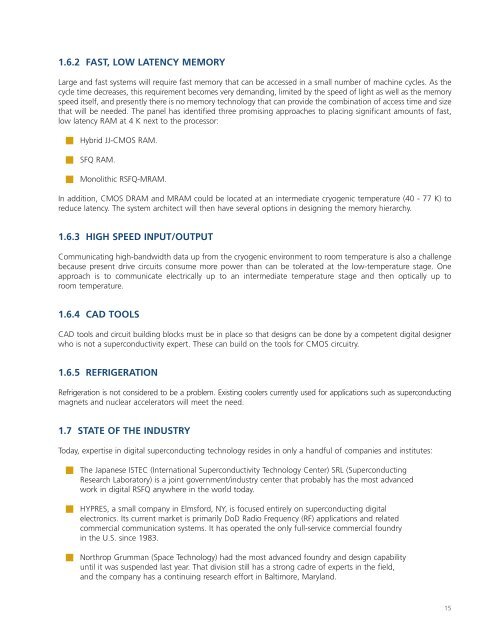Superconducting Technology Assessment - nitrd
Superconducting Technology Assessment - nitrd
Superconducting Technology Assessment - nitrd
Create successful ePaper yourself
Turn your PDF publications into a flip-book with our unique Google optimized e-Paper software.
1.6.2 FAST, LOW LATENCY MEMORY<br />
Large and fast systems will require fast memory that can be accessed in a small number of machine cycles. As the<br />
cycle time decreases, this requirement becomes very demanding, limited by the speed of light as well as the memory<br />
speed itself, and presently there is no memory technology that can provide the combination of access time and size<br />
that will be needed. The panel has identified three promising approaches to placing significant amounts of fast,<br />
low latency RAM at 4 K next to the processor:<br />
■<br />
■<br />
■<br />
Hybrid JJ-CMOS RAM.<br />
SFQ RAM.<br />
Monolithic RSFQ-MRAM.<br />
In addition, CMOS DRAM and MRAM could be located at an intermediate cryogenic temperature (40 - 77 K) to<br />
reduce latency. The system architect will then have several options in designing the memory hierarchy.<br />
1.6.3 HIGH SPEED INPUT/OUTPUT<br />
Communicating high-bandwidth data up from the cryogenic environment to room temperature is also a challenge<br />
because present drive circuits consume more power than can be tolerated at the low-temperature stage. One<br />
approach is to communicate electrically up to an intermediate temperature stage and then optically up to<br />
room temperature.<br />
1.6.4 CAD TOOLS<br />
CAD tools and circuit building blocks must be in place so that designs can be done by a competent digital designer<br />
who is not a superconductivity expert. These can build on the tools for CMOS circuitry.<br />
1.6.5 REFRIGERATION<br />
Refrigeration is not considered to be a problem. Existing coolers currently used for applications such as superconducting<br />
magnets and nuclear accelerators will meet the need.<br />
1.7 STATE OF THE INDUSTRY<br />
Today, expertise in digital superconducting technology resides in only a handful of companies and institutes:<br />
■<br />
■<br />
■<br />
The Japanese ISTEC (International Superconductivity <strong>Technology</strong> Center) SRL (<strong>Superconducting</strong><br />
Research Laboratory) is a joint government/industry center that probably has the most advanced<br />
work in digital RSFQ anywhere in the world today.<br />
HYPRES, a small company in Elmsford, NY, is focused entirely on superconducting digital<br />
electronics. Its current market is primarily DoD Radio Frequency (RF) applications and related<br />
commercial communication systems. It has operated the only full-service commercial foundry<br />
in the U.S. since 1983.<br />
Northrop Grumman (Space <strong>Technology</strong>) had the most advanced foundry and design capability<br />
until it was suspended last year. That division still has a strong cadre of experts in the field,<br />
and the company has a continuing research effort in Baltimore, Maryland.<br />
15














